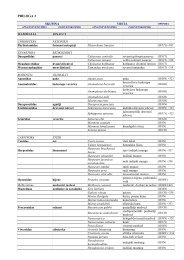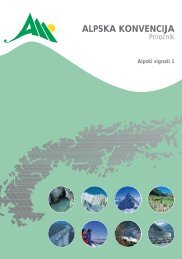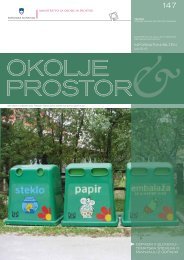Atlas of Flood Maps
Atlas of Flood Maps
Atlas of Flood Maps
Create successful ePaper yourself
Turn your PDF publications into a flip-book with our unique Google optimized e-Paper software.
EU <strong>Flood</strong> Risk <strong>Maps</strong> Q4310 September, 2007<br />
Examples from EU countries<br />
WL | Delft Hydraulics<br />
4.5 Great Britain<br />
4.5.1 England & Wales<br />
General information<br />
In England & Wales the Environment Agency has developed several mapping products to<br />
raise awareness <strong>of</strong> flood risk and support decision making. Examples <strong>of</strong> these are shown as<br />
Figure 4.24 to Figure 4.28. All are available for public or pr<strong>of</strong>essional use; some data is<br />
published on the Environment Agency’s internet site 4 .<br />
The <strong>Flood</strong> Map is currently the Environment Agency’s main map to raise awareness <strong>of</strong> flood<br />
risk with the public and our partner organisations, such as land use/spatial planning<br />
authorities, emergency planners, emergency services, developers and drainage authorities.<br />
It has been available on the internet since 2004, although an earlier version was first<br />
published on the Internet in 2000. The <strong>Flood</strong> Map shows:<br />
� <strong>Flood</strong>ing from rivers or the sea without defences – the natural flood plain area that could<br />
be affected in the event <strong>of</strong> flooding from rivers and the sea.<br />
Two shaded areas are presented, which are aligned with the <strong>Flood</strong> Zones as defined by<br />
land use planning policy for England:<br />
� Areas that could be flooded either from rivers with an annual probability <strong>of</strong> flooding<br />
greater than 1% (1 in 100) OR areas that could be flooded from the sea with an<br />
annual probability <strong>of</strong> flooding greater than 0.5% (1 in 200)<br />
� Areas other than covered by the above that would be flooded by an extreme flood<br />
with an annual probability <strong>of</strong> 0.1% (1 in 1000) from rivers and the sea<br />
� The location <strong>of</strong> flood defences – such as embankments and walls, and flood storage<br />
areas<br />
� Areas benefiting from these flood defences in a 1% fluvial flood or 0.5% coastal flood –<br />
where possible the areas that benefit from the flood defences are shown. However, not<br />
all areas that benefit from flood defences are currently shown (Figure 4.24 is an<br />
example <strong>of</strong> this). Figure 4.25 shows how areas benefiting from defences are shown<br />
where the information is available. There is ongoing work to increase the coverage <strong>of</strong><br />
this information.<br />
On the internet the <strong>Flood</strong> Map is presented as a single layer in map form. Users search for<br />
their location <strong>of</strong> interest through a standard search tool by entering either a post code or a<br />
location name. The mapped output shown on the internet site (default scale 1:20,000) is very<br />
similar to Figure 4.24, which has been shown at a scale <strong>of</strong> about 1:45,000.<br />
The online <strong>Flood</strong> Map also has the facility to allow users to gain further information by<br />
opting to ‘learn more’ by pointing at a specific location within the map. This leads to data<br />
from the National <strong>Flood</strong> Risk Assessment, a mapped data set which provides further<br />
qualitative information on the probability <strong>of</strong> flooding taking into account the location, type<br />
4 http://www.environment-agency.gov.uk/<br />
4—23







